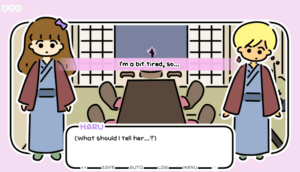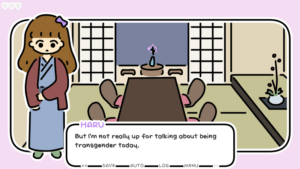Embarking on the narrative journey of “One Night Hot Springs,” a visual novel developed by npckc and available on Steam, the player is taken on an explorative journey of gender identity. One of its profound elements is its portrayal of the communication difficulties often experienced by transgender individuals.
“One Night Hot Springs” targets a broad audience through its focus on providing the fun of narrative experience. “One Night Hot Springs” navigates the emotional landscape of Haru, a transgender woman finding her way in the world as she spends time with two friends in the hot springs.

The game depicts Haru’s obstacles in communicating her identity and struggles to her friends. In addition, it displays the societal pressure and the burden of misunderstanding that transgender people often carry, offering a window into the real-world issues they face daily. This exploration of interpersonal communication from the perspective of a transgender woman is a rare and much-needed perspective in the gaming world.

The game’s feminist storytelling mainly lies in the depiction of how Haru navigates societal norms in a culture steeped in prejudice against transgender people. Through Haru, the game humanizes and gives visibility to the transgender community, a group often marginalized or misrepresented in gaming and media. Haru’s experiences, fears, and challenges – involving acceptance by the people they care about and their social circles – are brought to the forefront, unveiling a reality many transgender individuals face daily. The game does a great job of communicating this truth, creating a narrative that resonates with diverse audiences, regardless of their experiences with gender identity.
However, there are areas where the game could deepen its exploration of feminist themes. For instance, developing supporting characters could offer a more profound understanding of Haru’s world. It is usually up to the reader to read between the lines and apply the ideas in the real world. The player could benefit from more insight into the thought processes of her friends: why Manami feels protective over Haru and Erika’s first impression of her. By delving into other characters’ perspectives, the game could highlight the array of attitudes and biases Haru must contend with. This, in turn, would provide players with a richer context for Haru’s experiences.
Moreover, the game’s environmental storytelling could also be enhanced to provide more visibility into Haru’s internal thoughts and emotions. Visual cues, symbolic elements, and narrative snippets that echo Haru’s feelings could be woven into the game environment, offering subtle insights into her psychological journey.
The narrative framework of “One Night Hot Springs” diverges from typical video game formats, which is a step in the right direction in revolutionizing the gaming industry. By shifting the focus from combat or competitive gameplay to understanding and empathizing with Haru’s experience, the game allows players to engage more deeply with her story. In addition, this design choice embodies a feminist perspective, places importance on a shared understanding of feminist ideals, and tears down the toxic gaming culture discussed in the reading.
Discussion question: Would allowing the player to play as the other character – to switch in the middle of the game or after a chapter – be an excellent way to illuminate the player towards the thought patterns of the other players? Or would a better way be to simply express it within the game’s narrative as the player goes on?



